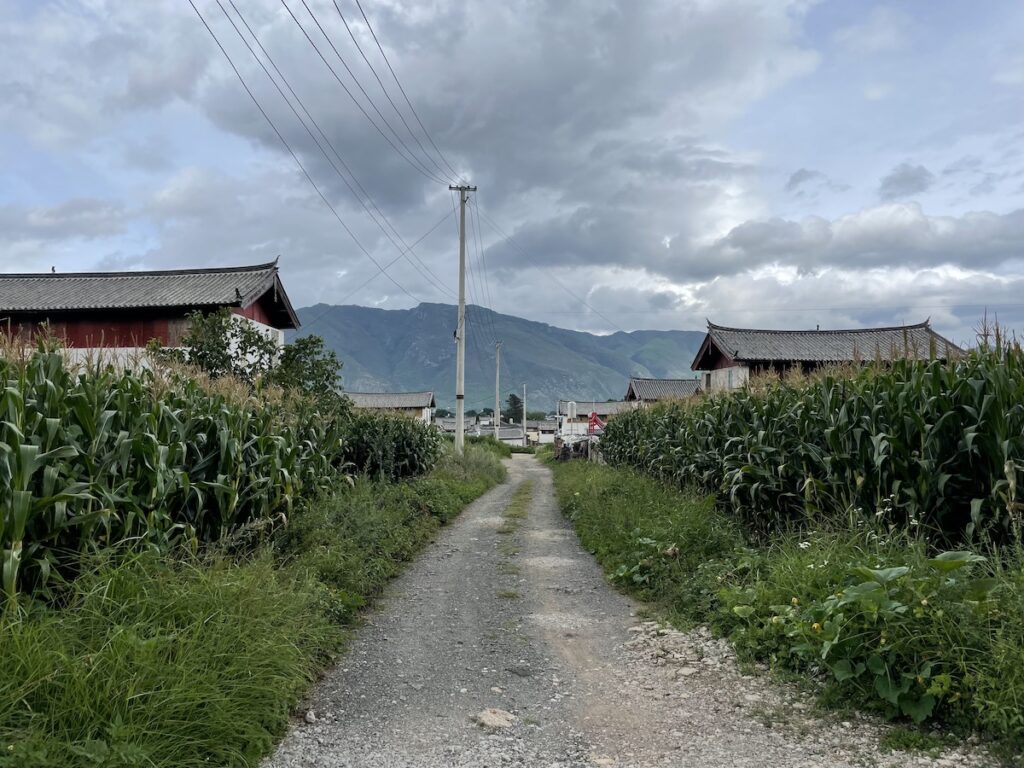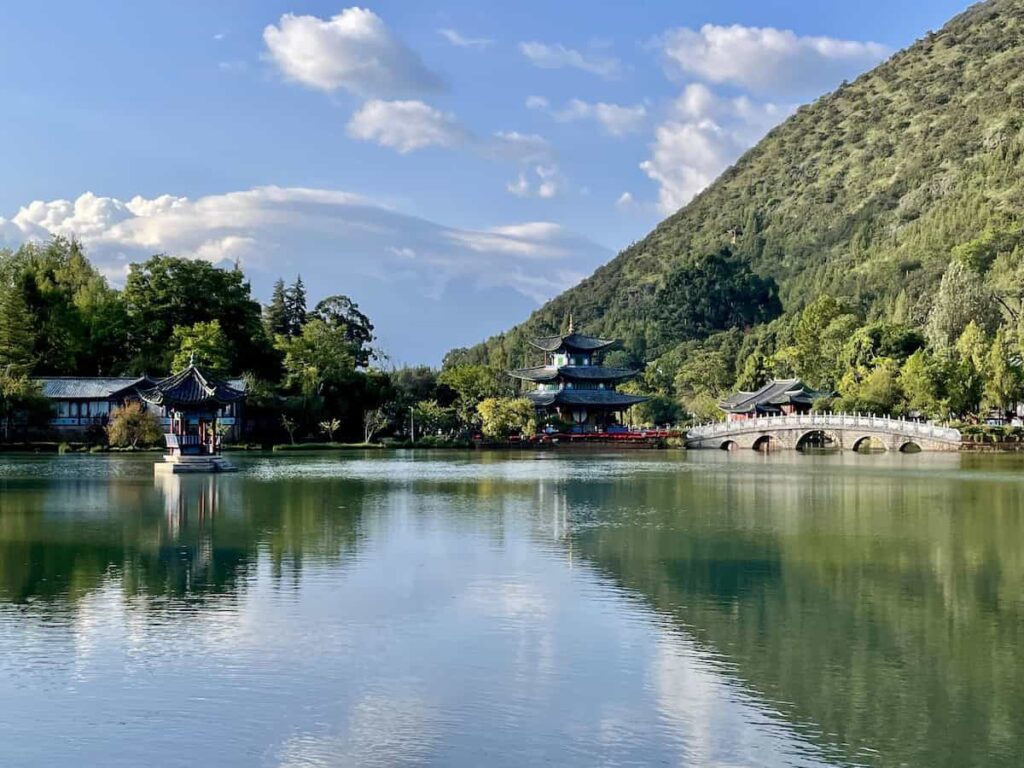Do you want to travel back in time? Be careful. Anything you do in the past might alter the present, with grave consequences. Better yet, skip the dangers of causality altogether and visit the ancient city of Lijiang, China.
Visiting the ancient city of Lijiang is like stepping back in time—albeit with a modern twist. Picture a place where historic charm meets lively tourism, complete with bustling nightclubs and shops selling everything from souvenirs to temporary tattoos. While Lijiang may not be the epitome of authenticity, it offers a vibrant and entertaining experience that’s sure to delight any traveler.
About Lijiang
Nestled in the mountains of Yunnan province, Lijiang lies in the northwest corner of China, close to the Sichuan border. The city boasts an airport that connects it to major cities across China, while convenient high-speed trains arrive daily from Kunming. For an easy day trip, you can also hop on trains between Lijiang and Dali or take a bus to the enchanting Shangri-La.
Lijiang is the ancestral home of the Naxi people, one of China’s 55 recognized ethnic minorities. With a history spanning over 1,000 years, Lijiang played a crucial role as a key stop on the ancient Tea Horse Road. I guess you could say they’ve been getting tourists for centuries. The city was famously conquered by Kublai Khan in 1253, and its residents later supported the Ming dynasty’s conquest of Yunnan. In gratitude for their assistance, the Ming granted the ruling Naxi family the title of “Mu.” This family governed Lijiang for centuries until the Qing dynasty took control in 1723.
The Naxi People
The Naxi people live mostly around Lijiang as well as parts of Tibet and Sichuan Province. Although lots of Han Chinese have moved into Lijiang, the city has still kept a lot of its unique culture and flavor.
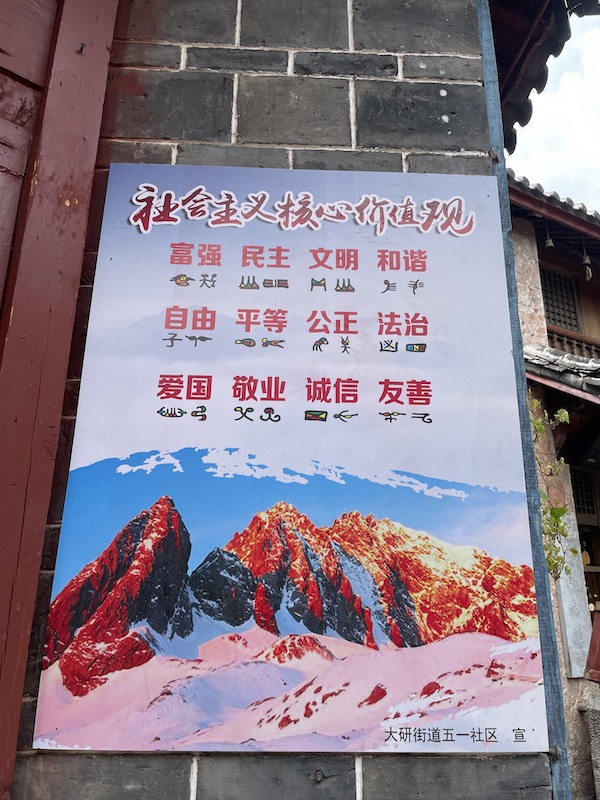
One of the most interesting examples of Naxi culture is the language. The Naxi people have their own unique language, obviously, but also their own writing. They use pictographs rather than letters or Chinese characters. These Naxi symbols are one of the few pictographic writing systems still in use today. This isn’t just some ancient, lost, writing. You can still find Naxi pictographs on street signs and posters throughout Lijiang.
The Naxi are also traditionally matrilineal. The Mosuo people, a related group that lives a hundred or so kilometers from Lijiang around Lugu Lake, are famous for their unique “walking marriages.” The man walks to the woman’s house, and she decides whether or not she wants to do the nasty with him. If she’s into it, he spends the night but has to walk home in the morning. Children rarely know who their fathers are, and that role is usually played by their uncles.
Of course, the Mosuo and Naxi people aren’t immune to the pressures of modern society, and these traditions are fading away. However, even today you will find that women make up the majority of shopkeepers and restauranteurs in Lijiang.
Top Attractions in Lijiang
Lijiang is packed with things to do. The city sits under the shadow of the monumental Jade Dragon Snow Mountain. This mountain was so nice, I had to give it its own blog post.
If you’re feeling adventurous, Lijiang is also an excellent base for exploring Tiger Leaping Gorge. Unfortunately, July and August are the rainy season and summer storms can make hiking through the gorge a little too dangerous. When did we visit Lijiang? August, of course.
But, even though we missed Tiger Leaping Gorge, Lijiang was still full of cool stuff to see.
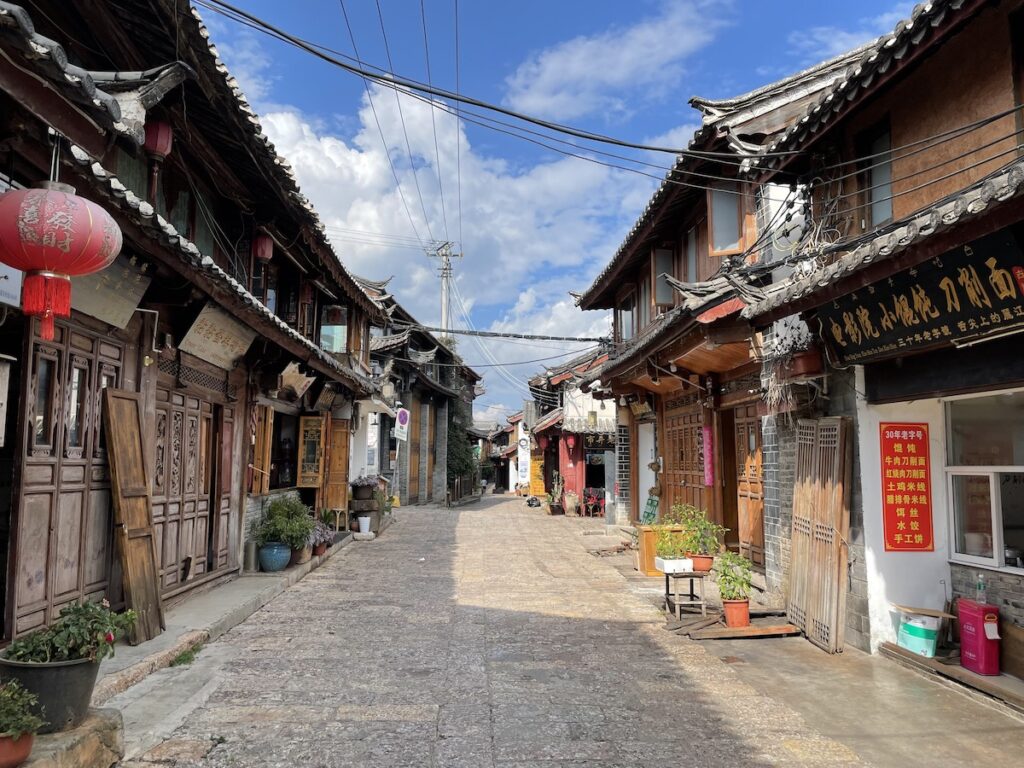
Lijiang Old Town
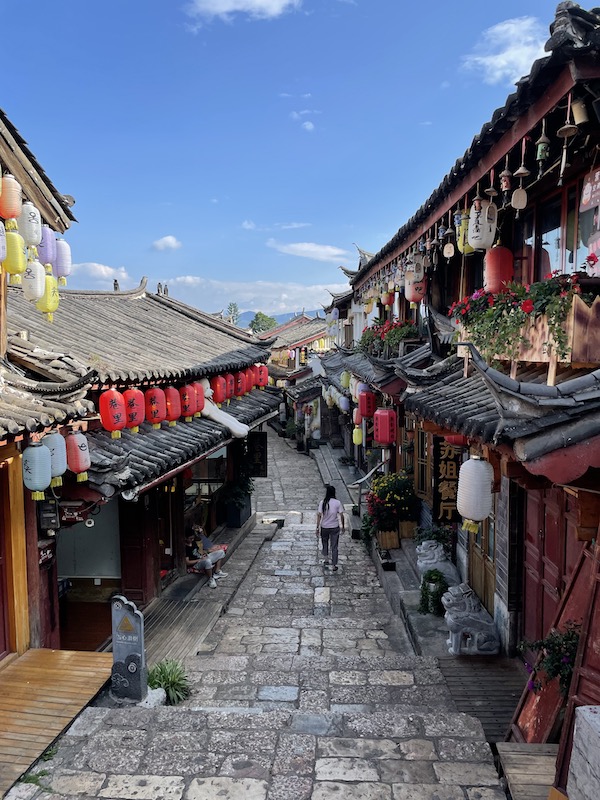
The top attraction in Lijiang is undoubtedly its Old Town, a UNESCO World Heritage Site. This enchanting area features a winding maze of charming cobblestone streets, picturesque canals, and delightful stone buildings. Like many historic towns in China, most of the structures have been transformed into vibrant restaurants, cozy hotels, and unique souvenir shops. Alongside a meandering canal, you’ll find a lively street filled with bars and nightclubs, where music spills into the night. And if you’re a fan of fresh juice, you’ll encounter about a million shops selling pomegranate juice. Trust me, the pomegranate juice here is way better than any of that over-priced, bottled crap.
And, like every other tourist spot in China, the streets of Lijiang are crowded asses to elbows with Chinese tourists. Some people hate this sort of thing, but if you let yourself relax and get swept along with the crowd, it can make for a fun, almost carnival-like atmosphere.
Also, unlike some other old towns (I’m looking at you, Dali), there are no cars allowed in the center of Lijiang.
If the crowds and tourist shops are too much for you, don’t worry. There are plenty more things to do in Lijiang. You can visit the nearby villages of Baisha and Shuhe, for example. Both of these are absolutely lovely, far less crowded, and more ‘authentic’ feeling than Lijiang.
Mu’s Palace and the Black Dragon Pool and Beyond
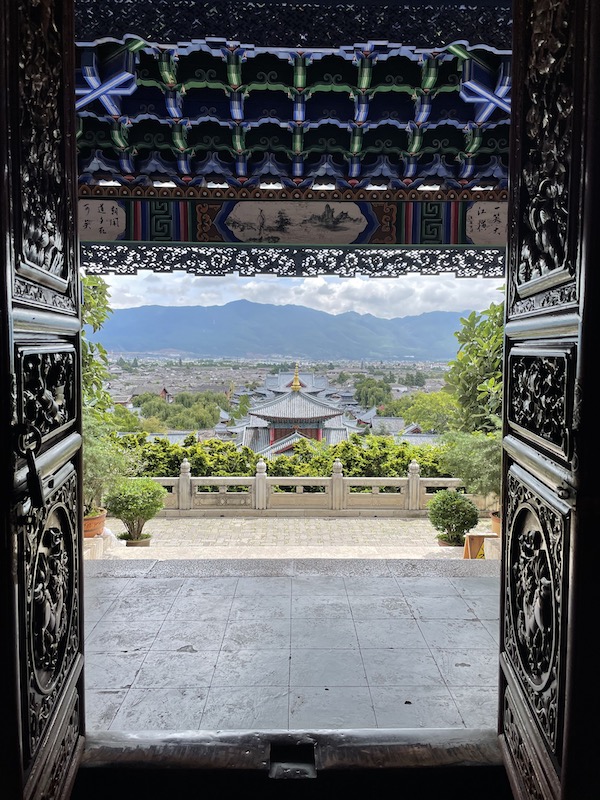
Remember when I talked about the Mu family that ruled Lijiang back in the day? If you want, you can go visit their palace. It’s one of the best things to do in Lijiang. The Mu family palace pales in comparison to, say, the Forbidden City in Beijing, but it’s still a nice place to wander around for a few hours and soak up some traditional architecture. There’s a hill in the back where you can get a great view of the old town.
If Mu’s palace isn’t enough and you want to visit another cultural attraction in Lijiang, there’s the Black Dragon Pool Park, also known as Jade Spring Park. The Chinese love their poetic names. The park is a short walk north of Lijiang ancient town. You’ll have to pay to get in, but it’s only 80 RMB, and is worth it.
Black Dragon Pool Park has a few nice pavilions and walking trails that circle around a small lake. The park also offers an incredibly iconic view of Jade Dragon Snow Mountain towering behind a Chinese bridge and pavilion. Okay, so maybe there’s a pretty good chance you won’t get the view. Lijiang can be very cloudy. We couldn’t see the mountain at all when were were there. However, it was still a very nice park.
Finally, if you head along the road leaving town towards Jade Dragon Snow Mountain, you’ll find a wonderful little public square with an impressive statue of Chairman Mao. Other than Mao, there isn’t much in the modern city aside from a few cheap restaurants and local people going about their lives.
But I Heard it was Terrible…
Not everyone is as into Lijiang as I was. Here are some reviews from TripAdvisor: “just another chinese commercial mall”, “Chinese Disneyland”, “shamelessly unauthentic crass ‘old town’ with lots of similar shops”, “endless, joyless hordes of Chinese tourists” and my favorite, “sometimes, I wake up terrified, bathing in sweat, thinking im back in Old town Liniang…. I imagne it is what hell must be like.”
These seem a little extreme to me. Oftentimes, when you are traveling in China, you will find many Chinese tourists. There are a lot of Chinese people in China, and they like to travel. Deal with it.
As for the commercialism and similar shops of the old town, well, yeah. It’s unfortunate that popular tourist spots tend to get commercialized. However, it isn’t just a Lijiang thing or even just a Chinese thing. This happens all over the world. It’s unfortunate, but we’re probably going to have to deal with it until after the revolution.
But until we can smash capitalism, just relax and let yourself enjoy the touristy trip back in time that is Lijiang.
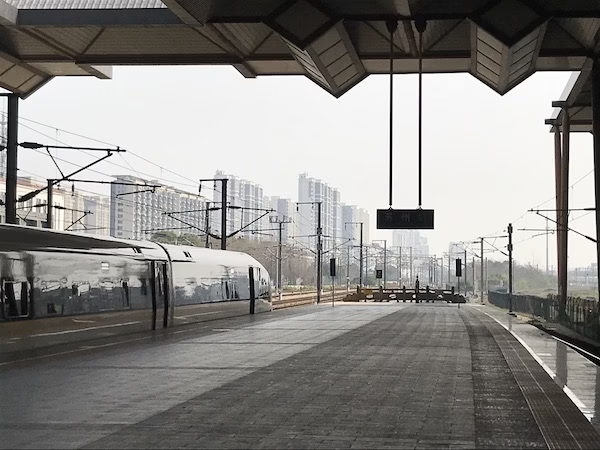
Need Train Tickets in China?
China’s high speed rail network is fast and efficient, but it’s difficult for non-Chinese citizens to get tickets. Fortunately, Trip.com makes buying train tickets as hassle free as traveling through China can possibly be. Click the link below to get your Chinese train tickets. If you buy your train tickets using the link, I’ll receive a small commission and you’ll feel good knowing you’ve helped out an independent blogger.
